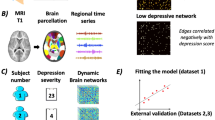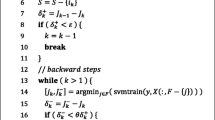Abstract
Major depressive disorder (MDD), a debilitating mental illness, could cause functional disabilities and could become a social problem. An accurate and early diagnosis for depression could become challenging. This paper proposed a machine learning framework involving EEG-derived synchronization likelihood (SL) features as input data for automatic diagnosis of MDD. It was hypothesized that EEG-based SL features could discriminate MDD patients and healthy controls with an acceptable accuracy better than measures such as interhemispheric coherence and mutual information. In this work, classification models such as support vector machine (SVM), logistic regression (LR) and Naïve Bayesian (NB) were employed to model relationship between the EEG features and the study groups (MDD patient and healthy controls) and ultimately achieved discrimination of study participants. The results indicated that the classification rates were better than chance. More specifically, the study resulted into SVM classification accuracy = 98%, sensitivity = 99.9%, specificity = 95% and f-measure = 0.97; LR classification accuracy = 91.7%, sensitivity = 86.66%, specificity = 96.6% and f-measure = 0.90; NB classification accuracy = 93.6%, sensitivity = 100%, specificity = 87.9% and f-measure = 0.95. In conclusion, SL could be a promising method for diagnosing depression. The findings could be generalized to develop a robust CAD-based tool that may help for clinical purposes.



Similar content being viewed by others
References
A. American Psychiatric Association and A. P. Association (1994) Diagnostic and statistical manual of mental disorders
A. P. Association (2013) Diagnostic and statistical manual of mental disorders (DSM-5®). American Psychiatric Pub, Arlington
Acharya UR, Faust O, Kannathal N, Chua T, Laxminarayan S (2005) Non-linear analysis of EEG signals at various sleep stages. Comput Methods Programs Biomed 80:37–45
Acharya UR, Sree SV, Alvin APC, Yanti R, Suri JS (2012) Application of non-linear and wavelet based features for the automated identification of epileptic EEG signals. Int J Neural Syst 22:1–14
Acharya UR, Sudarshan V, Adeli H, Santhosh J, Koh J, Adeli A (2015) Computer-aided diagnosis of depression using EEG signals. Eur Neurol 73:329–336
Acharya UR, Sudarshan VK, Adeli H, Santhosh J, Koh JE, Puthankatti SD et al (2015) A novel depression diagnosis index using nonlinear features in EEG signals. Eur Neurol 74:79–83
Adeli H, Ghosh-Dastidar S, Dadmehr N (2007) A wavelet-chaos methodology for analysis of EEGs and EEG subbands to detect seizure and epilepsy. IEEE Trans Biomed Eng 54:205–211
Ahmadlou M, Adeli H, Adeli A (2012) Fractality analysis of frontal brain in major depressive disorder. Int J Psychophysiol 85:206–211
Alhaj H, Wisniewski G, McAllister-Williams RH (2011) The use of the EEG in measuring therapeutic drug action: focus on depression and antidepressants. J Psychopharmacol 25:1175–1191
Anand A, Li Y, Wang Y, Wu J, Gao S, Bukhari L et al (2005) Activity and connectivity of brain mood regulating circuit in depression: a functional magnetic resonance study. Biol Psychiatry 57:1079–1088
Bae JN, MacFall JR, Krishnan KRR, Payne ME, Steffens DC, Taylor WD (2006) Dorsolateral prefrontal cortex and anterior cingulate cortex white matter alterations in late-life depression. Biol Psychiatry 60:1356–1363
Berg P, Scherg M (1994) A multiple source approach to the correction of eye artifacts. Electroencephalogr Clin Neurophysiol 90:229–241
Culpepper L (2014) Misdiagnosis of bipolar depression in primary care practices. J Clin Psychiatry 75:e05–e05
Erguzel TT, Ozekes S, Tan O, Gultekin S (2015) Feature selection and classification of electroencephalographic signals an artificial neural network and genetic algorithm based approach. Clin EEG Neurosci 46:321–326
Fingelkurts AA, Fingelkurts AA, Rytsälä H, Suominen K, Isometsä E, Kähkönen S (2007) Impaired functional connectivity at EEG alpha and theta frequency bands in major depression. Hum Brain Mapp 28:247–261
Greenberg PE, Fournier A-A, Sisitsky T, Pike CT, Kessler RC (2015) The economic burden of adults with major depressive disorder in the United States (2005 and 2010). J Clin Psychiatry 76:155–162
Guo H, Cao X, Liu Z, Li H, Chen J, Zhang K (2012) Machine learning classifier using abnormal brain network topological metrics in major depressive disorder. NeuroReport 23:1006–1011
Hamilton JP, Gotlib IH (2008) Neural substrates of increased memory sensitivity for negative stimuli in major depression. Biol Psychiatry 63:1155–1162
Hoechstetter K, Berg P, Scherg M (2010) BESA research tutorial 4: distributed source imaging. BESA Research Tutorial, pp 1–29
Hosmer DW Jr, Lemeshow S (2004) Applied logistic regression. Wiley, New York
Hosseinifard B, Moradi MH, Rostami R (2013) Classifying depression patients and normal subjects using machine learning techniques and nonlinear features from EEG signal. Comput Methods Programs Biomed 109:339–345
Jalili M, Knyazeva MG (2011) EEG-based functional networks in schizophrenia. Comput Biol Med 41:1178–1186
Jasper HH (1958) The ten twenty electrode system of the international federation. Electroencephalogr Clin Neurophysiol 10:371–375
Kalatzis I, Piliouras N, Ventouras E, Papageorgiou CC, Rabavilas AD, Cavouras D (2004) Design and implementation of an SVM-based computer classification system for discriminating depressive patients from healthy controls using the P600 component of ERP signals. Comput Methods Programs Biomed 75:11–22
Klöppel S, Abdulkadir A, Jack CR, Koutsouleris N, Mourão-Miranda J, Vemuri P (2012) Diagnostic neuroimaging across diseases. Neuroimage 61:457–463
Knott V, Mahoney C, Kennedy S, Evans K (2001) EEG power, frequency, asymmetry and coherence in male depression. Psychiatry Res Neuroimaging 106:123–140
Lee J-S, Yang B-H, Lee J-H, Choi J-H, Choi I-G, Kim S-B (2007) Detrended fluctuation analysis of resting EEG in depressed outpatients and healthy controls. Clin Neurophysiol 118:2489–2496
Lee T-W, Wu Y-T, Yu YW-Y, Chen M-C, Chen T-J (2011) The implication of functional connectivity strength in predicting treatment response of major depressive disorder: a resting EEG study. Psychiatry Res Neuroimaging 194:372–377
Lehmann C, Koenig T, Jelic V, Prichep L, John RE, Wahlund L-O et al (2007) Application and comparison of classification algorithms for recognition of Alzheimer’s disease in electrical brain activity (EEG). J Neurosci Methods 161:342–350
Li Y, Li Y, Tong S, Tang Y, Zhu Y (2007) More normal EEGs of depression patients during mental arithmetic than rest. In: Noninvasive functional source imaging of the brain and heart and the international conference on functional biomedical imaging, 2007. Joint meeting of the 6th international symposium on NFSI-ICFBI 2007, pp 165–168
Liu H, Motoda H (2007) Computational methods of feature selection. CRC Press, Boca Raton
Magnin B, Mesrob L, Kinkingnéhun S, Pélégrini-Issac M, Colliot O, Sarazin M et al (2009) Support vector machine-based classification of Alzheimer’s disease from whole-brain anatomical MRI. Neuroradiology 51:73–83
Mahmud WMRW, Awang A, Herman I, Mohamed MN (2004) Analysis of the psychometric properties of the Malay version of Beck Depression Inventory II (BDI-II) among postpartum women in Kedah, north west of peninsular Malaysia. Malays J Med Sci MJMS 11:19
Mamitsuka H (2006) Selecting features in microarray classification using ROC curves. Pattern Recogn 39:2393–2404
Mitchell TM (1997) Machine learning. WCB ed: McGraw-Hill, Boston
Mohammadi M, Al-Azab F, Raahemi B, Richards G, Jaworska N, Smith D et al (2015) Data mining EEG signals in depression for their diagnostic value. BMC Med Inform Decis Mak 15:1
Mumtaz W, Malik AS, Yasin MAM, Xia L (2015) Review on EEG and ERP predictive biomarkers for major depressive disorder. Biomed Signal Process Control 22:85–98
Mumtaz W, Vuong PL, Xia L, Malik AS, Rashid RBA (2016) Automatic diagnosis of alcohol use disorder using EEG features. Knowl-Based Syst 105:48–59
Mumtaz W, Xia L, Ali SSA, Yasin MAM, Hussain M, Malik AS (2017) Electroencephalogram (EEG)-based computer-aided technique to diagnose major depressive disorder (MDD). Biomed Signal Process Control 31:108–115
Mwangi B, Ebmeier KP, Matthews K, Steele JD (2012) Multi-centre diagnostic classification of individual structural neuroimaging scans from patients with major depressive disorder. Brain 135:1508–1521
Olbrich S, Arns M (2013) EEG biomarkers in major depressive disorder: discriminative power and prediction of treatment response. Int Rev Psychiatry 25:604–618
Olbrich S, Tränkner A, Chittka T, Hegerl U, Schönknecht P (2014) Functional connectivity in major depression: increased phase synchronization between frontal cortical EEG-source estimates. Psychiatry Res Neuroimaging 222:91–99
Olofsen E, Sleigh J, Dahan A (2008) Permutation entropy of the electroencephalogram: a measure of anaesthetic drug effect. Br J Anaesth 101:810–821
Orrù G, Pettersson-Yeo W, Marquand AF, Sartori G, Mechelli A (2012) Using support vector machine to identify imaging biomarkers of neurological and psychiatric disease: a critical review. Neurosci Biobehav Rev 36:1140–1152
Park C-A, Kwon R-J, Kim S, Jang H-R, Chae J-H, Kim T et al (2006) Decreased phase synchronization of the EEG in patients with major depressive disorder. World Congress Med Phys Biomed Eng 2007:1095–1098
Puthankattil SD, Joseph PK (2012) Classification of EEG signals in normal and depression conditions by ANN using RWE and signal entropy. J Mech Med Biol 12:1240019
Qin Y, Xu P, Yao D (2010) A comparative study of different references for EEG default mode network: the use of the infinity reference. Clin Neurophysiol 121:1981–1991
Ramasubbu R, Brown MR, Cortese F, Gaxiola I, Goodyear B, Greenshaw AJ et al (2016) Accuracy of automated classification of major depressive disorder as a function of symptom severity. NeuroImage Clin 12:320–331
Stam C, Van Dijk B (2002) Synchronization likelihood: an unbiased measure of generalized synchronization in multivariate data sets. Phys D 163:236–251
Stam C, Montez T, Jones B, Rombouts S, Van Der Made Y, Pijnenburg Y et al (2005) Disturbed fluctuations of resting state EEG synchronization in Alzheimer’s disease. Clin Neurophysiol 116:708–715
Takens F (1981) Detecting strange attractors in turbulence. In: Dynamical systems and turbulence, Warwick 1980 (ed). Springer, pp. 366–381
Theiler J (1986) Spurious dimension from correlation algorithms applied to limited time-series data. Phys Rev A 34:2427
Vapnik VN, Vapnik V (1998) Statistical learning theory, vol 2. Wiley, New York
Volkert J, Schulz H, Härter M, Wlodarczyk O, Andreas S (2013) The prevalence of mental disorders in older people in Western countries—a meta-analysis. Ageing Res Rev 12:339–353
Willner P, Scheel-Krüger J, Belzung C (2013) The neurobiology of depression and antidepressant action. Neurosci Biobehav Rev 37:2331–2371
Zeng LL, Shen H, Liu L, Hu D (2014) Unsupervised classification of major depression using functional connectivity MRI. Hum Brain Mapp 35:1630–1641
Acknowledgement
This research work was supported by HiCoE research fund, Grant Number (0153CA-005), Ministry of Higher Education (MoHE), Malaysia.
Author information
Authors and Affiliations
Corresponding author
Ethics declarations
Conflict of interest
There is no conflict of interest found for this study.
Additional information
All authors have equal contribution for this research work.
Rights and permissions
About this article
Cite this article
Mumtaz, W., Ali, S.S.A., Yasin, M.A.M. et al. A machine learning framework involving EEG-based functional connectivity to diagnose major depressive disorder (MDD). Med Biol Eng Comput 56, 233–246 (2018). https://doi.org/10.1007/s11517-017-1685-z
Received:
Accepted:
Published:
Issue Date:
DOI: https://doi.org/10.1007/s11517-017-1685-z




